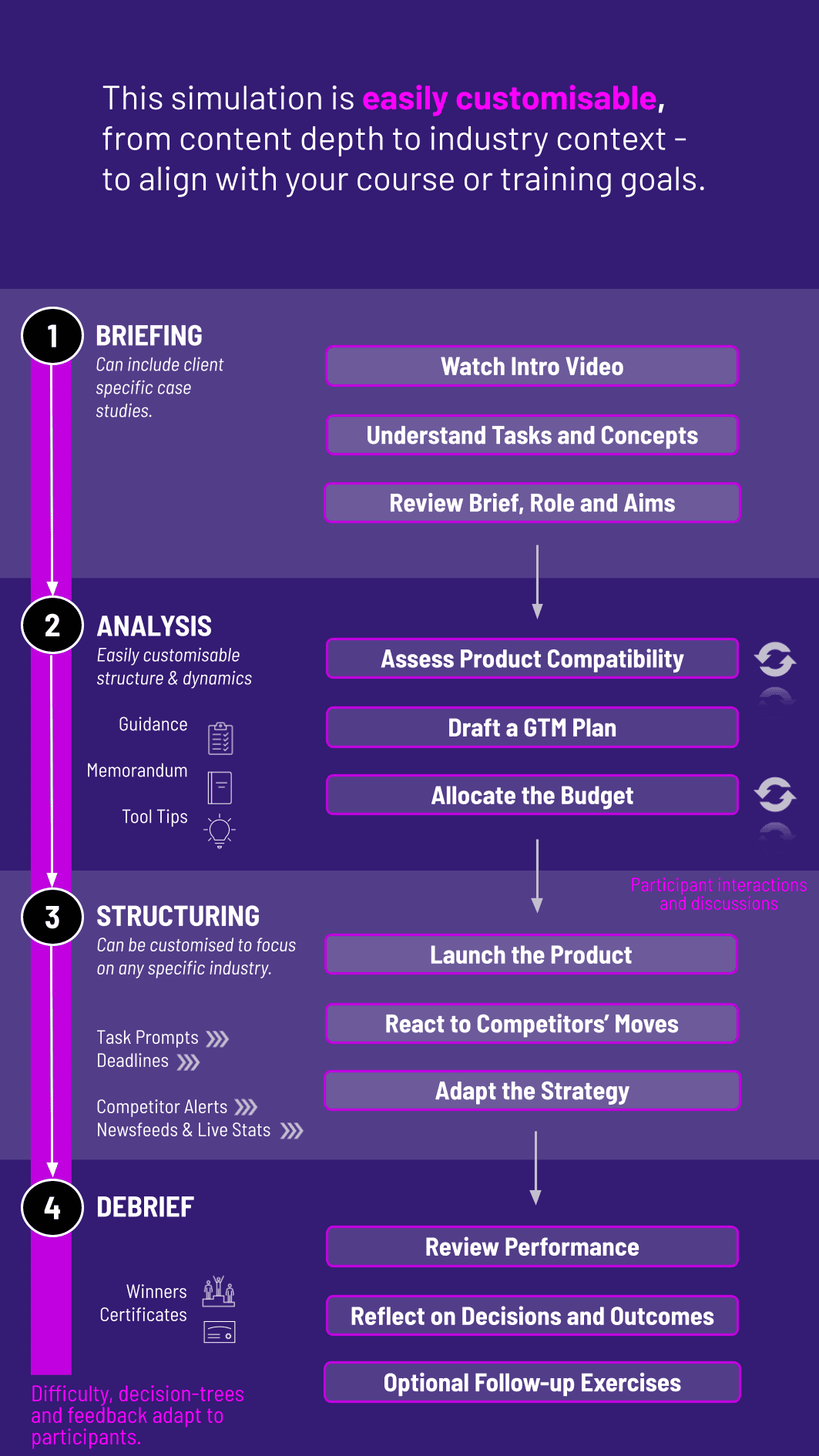
In this hands-on Go-To-Market Strategy Simulation, participants step into the role of commercial leads designing, testing, and executing go-to-market plans across pricing, channels, messaging, and sales execution - all under real-world constraints.
Segmentation and targeting
Positioning and messaging
Pricing strategy and discounting
Channel mix and distribution
Product readiness and alignment
Sales enablement and training
Marketing campaign planning
Budget allocation across channels
Competitive analysis and response
Measuring success: KPIs and feedback loops


Develop and refine go-to-market plans
Choose positioning, messaging, and pricing for key segments
Allocate marketing budgets across paid, owned, and earned channels
Select and manage distribution and sales channels
Respond to new data: competitor launches, feedback, or internal constraints
Present launch strategies to senior stakeholders or investors
By the end of the simulation, participants will be able to:
Build a full go-to-market plan from scratch
Identify and prioritize target segments and buyer personas
Align messaging, channels, and pricing to customer needs
Test and iterate campaign strategy with real-time data
Allocate limited resources across competing goals
Balance short-term launch impact with long-term growth
Collaborate cross-functionally across marketing, sales, and product
Justify decisions with metrics and market logic
Respond to unexpected outcomes with agility
Present commercial strategies clearly to internal stakeholders
The simulation’s flexible structure ensures that these objectives can be calibrated to match the depth, duration, and focus areas of each program, whether in higher education or corporate learning.
This simulation is ideal for business schools, marketing bootcamps, corporate commercial training, and product launches. Each round represents a phase in the GTM journey - strategy design, launch execution, or adjustment post-launch.
1. Receive a Brief: Participants are given a product and market context, customer profiles, constraints, and launch goals. They may represent a startup, scale-up, or a large enterprise launching something new.
2. Explore and Strategize: Teams assess market research, competitor activity, internal capabilities, and past campaign data to design a go-to-market plan tailored to their target segments.
3. Make Go-To-Market Decisions: They choose messaging, channels, pricing, sales enablement tools, and allocate marketing spend - all within defined budget or team constraints.
4. Respond to Market Feedback: Launch results, competitor responses, or internal frictions are revealed. Teams must adapt plans and reallocate or re-prioritize.
5. Communicate and Reflect: Participants summarize their strategic choices, justify trade-offs, and explain results via short debriefs, memos, or presentations.
6. Repeat the Cycle: Each round builds on the last. Teams adapt their GTM strategy in real-time as new data emerges.
Is prior marketing or strategy experience required? No. The simulation is suitable for all levels, and includes guidance throughout.
Can this be run in teams or individually? Both. Teams are recommended for more collaborative learning. Roles can be assigned (Marketing, Sales, Product).
What industries are available? The simulation can be run in tech, FMCG, services, financial products, or customized to your industry.
Can we run this for a live product launch? Yes. The simulation structure can be customized to simulate your upcoming launch, with data and scenarios tailored accordingly.
What if participants disagree on strategy? That’s part of the learning. Structured decision logs and justifications are built in for reflection and iteration.
Are customer personas included? Yes. Each segment includes qualitative and quantitative data to aid decision-making.
Is it suitable for early-career professionals? Absolutely. It's often used in onboarding for product, sales, and marketing teams.
Does it include data analysis? Yes. Participants interpret sales data, CAC, channel effectiveness, customer feedback, and conversion metrics.
Alignment between strategy and market needs
Channel selection and budget optimization
Clarity and persuasiveness in GTM presentations
Responsiveness to feedback and competitive moves
Collaboration and internal alignment
Iterative improvement in launch outcomes
You can also include memo writing and debrief presentations as part of the assessment structure. Additionally, you can also add a built-in peer and self-assessment tool to see how participants rate themselves. This flexibility allows the simulation to be easily integrated by professors as graded courses at universities and by HR at assessment centres at companies.
Join this 20-minute webinar, followed by a Q&A session, to immerse yourself in the simulation.
or
Book a 15-minute Zoom demo with one of our experts to explore how the simulation can benefit you.